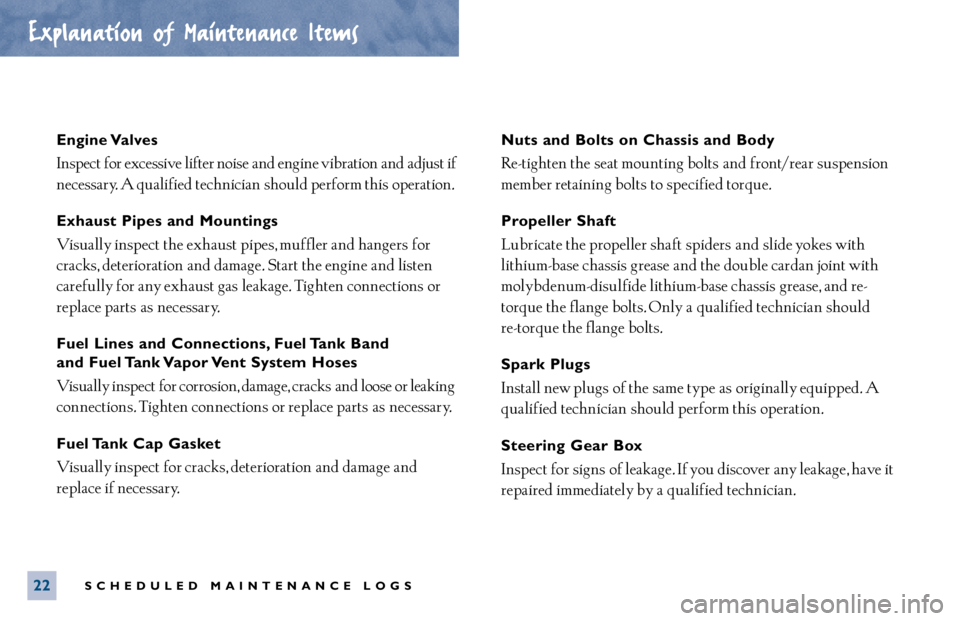Page 1073 of 4770

NEW FEATURES Ð 5S-FNE ENGINE10
�VALVE MECHANISM
1. Camshaft
To recover the reduction of engine performance, the intake valve timing and the amount of lift of the intake
and exhaust valves have been changed from those of the base 5S-FE engine.
�Specifications �
Valve TimingValve Lift mm (in.)
EngineIntakeExhaustIntakeExhaustEngine
OpenCloseOpenCloseIntakeExhaust
5S-FNE35 BTDC385 ABDC455 BBDC35 AT D C7.9 (0.311)8.25 (0.325)
5S-FE�435 ABDC��7.7 (0.303)7.7 (0.303)
2. Intake and Exhaust Valves
�To improve their wear resistance, the intake valves have undergone special heat treatment, and the material
of the exhaust valves has been changed.
�The shape of the stem to which the keepers attach has been changed to accommodate the adoption of
the cam with a high lift and of the inner shim type valve adjusting shims.
3. Valve Lifter and Adjusting shims
�TiN (titanium nitride) coated valve lifter is used to reduce the friction.
�To accommodate the high lift, inner shim type valve adjusting shims are used.
Intake Valve
167CN04
Valve LiftersAdjusting Shims
Exhaust Valve
4. Valve Spring
The valve springs for both the intake and exhaust sides accommodate the adoption of the cam with a high
lift and of the inner shim type valve adjusting shims. In addition, their spring rate has been optimized to
reduce friction.
Page 1076 of 4770
![TOYOTA CAMRY 2000 Service Repair Manual NF
NEW FEATURES Ð 5S-FNE ENGINE13
�FUEL SYSTEM
1. General
�The compressed gas [maximum pressure approximately 250 kg/cm2 (3600 psi, 24.8 MPa) @215C (705F)]
from the CNG fuel tank located in the rear TOYOTA CAMRY 2000 Service Repair Manual NF
NEW FEATURES Ð 5S-FNE ENGINE13
�FUEL SYSTEM
1. General
�The compressed gas [maximum pressure approximately 250 kg/cm2 (3600 psi, 24.8 MPa) @215C (705F)]
from the CNG fuel tank located in the rear](/manual-img/14/57447/w960_57447-1075.png)
NF
NEW FEATURES Ð 5S-FNE ENGINE13
�FUEL SYSTEM
1. General
�The compressed gas [maximum pressure approximately 250 kg/cm2 (3600 psi, 24.8 MPa) @215C (705F)]
from the CNG fuel tank located in the rear section of the vehicle is routed via a fuel filter to the engine
compartment. The pressure of the fuel is then reduced to 8 kg/cm
2 (114 psi, 785 kPa).
�A pressure regulator and injectors designed exclusively for CNG application have been adopted.
�A fuel pressure sensor and a fuel temperature sensor that are used for the correction of the fuel injection
volume are located on the delivery pipe.
�The fuel tank, pressure regulator, and the delivery pipe are provided with shutoff valves that shut off
the fuel when the ignition switch is turned OFF.
In addition, these valves shut off the fuel when the engine stalls, the SRS airbag is deployed, or the
pressure in the main pipe becomes abnormally low.
�A fuel temperature sensor for the fuel gauge is mounted on the tank valve assembly, and a fuel pressure
sensor is mounted immediately upstream of the pressure regulator.
�Fuel System Diagram �
167CN12
Discharge
Valve
Fuel
Pressure
SensorFuel Temp.
SensorFuel
Pressure
RegulatorFuel Shutoff ValveFuel TankFuel Shutoff Valve
Relief Valve
Inlet Check
Valve
Fuel Temp.
Sensor
Coupler
Tank Valve Assembly
Vent Tube Manual
Shutoff
Valve Fuel
Filter
Fuel
Pressure
Sensor
Fuel Shutoff Valve Injectors
Delivery Pipe
Page 1077 of 4770
NEW FEATURES Ð 5S-FNE ENGINE 14
2. Fuel Tank
�A fuel tank made with carbon fiber and alumi-
num lining has been adopted to prevent weight
increase.
�Because the fuel tank expands along with the
increase in the pressure of the compressed gas,
the tank bands contain coil springs to accommo-
date the fluctuation in the perimeter of the tank.
�The fuel tank is provided with a tank valve as-
sembly.
3. Tank Valve Assembly
General
The tank valve assembly is mounted on the tank
and consists of a fuel shutoff valve, inlet check
valve, relief valve and two manual cutoff valves.
167CN08
Coil Springs
Tank Valve
AssemblyTank Band
167CN26
Fuel
Temperatur
Sensor
Tank Valve Assembly
Page 1078 of 4770

NF
NEW FEATURES Ð 5S-FNE ENGINE15
Fuel Shutoff Valve for Fuel Tank
This valve uses an solenoid valve. The main pipe that supplies compressed gas to the engine is connected
to this valve, which opens when the ignition switch is turned ON. If the engine stalls, this valve automatical-
ly shuts off the fuel even if the ignition switch is turned ON. The valve reopens upon restarting the engine.
Also, this valve shuts off the fuel if the SRS airbag is deployed in a collision or if the pressure in the
main pipe becomes abnormally low.
Inlet Check Valve
Connected to a filler pipe that guides the fuel that fills through the coupler, the inlet check valve shuts
off by the force of a spring and by the pressure of the gas in the tank.
During filling, the pressure of the filling gas opens the inlet check valve.
Relief Valve
A vent tube is connected to this valve.
If the fuel tank is exposed to an abnormally high temperature, this valve opens (by melting) to discharge
the CNG at a predetermined temperature, thus preventing the fuel tank from bursting due to the increase
in gas pressure.
The discharged CNG is guided under the floor through a vent tube and is released outside of the vehicle.
4. Coupler
The coupler allows the fuel to be filled when it is connected with a fuel filling nozzle. The coupler has
a built-in check valve to prevent the CNG from flowing backward.
5. Manual Shutoff Valve
This valve is mounted below the vehicle floor.
When servicing the vehicle, this valve can be manu-
ally turned 90 degrees to shut off the main pipe.
167CN09
Page 1079 of 4770

NEW FEATURES Ð 5S-FNE ENGINE 16
6. Fuel Filter
Mounted below the vehicle floor, the fuel filter re-
moves any moisture or oil from the fuel.
7. Fuel Pressure Regulator
�The fuel pressure regulator regulates the fuel pressure by reducing the pressure of the compressed natural
gas from the fuel tank to the fuel injection pressure, which is 8 km/cm
2 (114 psi, 785 kPa).
�Similar to the fuel shutoff valve for the fuel tank, a fuel shutoff valve is provided on the fuel inlet side
of the fuel pressure regulator to shut off the supply of fuel when the engine is stopped or during abnormal
conditions.
�An oil separator that traps the moisture and oil in the fuel is provided on the low pressure side.
�A built-in relief valve is provided to protect the parts located on the low pressure side.
�While the fuel pressure is being reduced by the fuel pressure regulator, the Joule-Thomson effect associat-
ed with the expansion of the gas causes the fuel pressure regulator to be cooled excessively, exerting
unfavorable influence on the rubber parts such as diaphragms and fuel hoses.
Therefore, to raise the gas temperature, a water passage is provided in the fuel pressure regulator to
allow the engine coolant to warm the regulator.
Oil
Separator
Water Passage
Fuel
Shutoff
Valve
Relief Valve
167CN24 167CN25167CN10
Page 1080 of 4770

NF
NEW FEATURES Ð 5S-FNE ENGINE17
8. Delivery Pipe
�A delivery pipe with a wide passage that enables a large volume of gas to flow responsively has been
adopted to minimize the pressure loss.
�A fuel pressure sensor and a fuel temperature sensor that help correct the fuel injection volume are mounted
on the delivery pipe.
�Similar to the fuel shutoff valves for the fuel tank and the fuel pressure regulator, a fuel shutoff valve
is provided on the fuel inlet side of the delivery pipe to shut off the supply of fuel when the engine
is stopped or during abnormal conditions.
�To discharge the fuel out of the delivery pipe during service, a discharge valve is provided.
Injector
167CN13
Discharge
ValveFuel Pressure Sensor
Fuel Temp. Sensor
Delivery Pipe
CNG
Fuel Shutoff
Valve
9. Injector
For the injection of fuel in the gaseous state, injectors that allow the flow of a large volume of fuel and
provide improved sealing performance have been adopted.
These injectors are actuated by the voltage (150V) that has been increased by the voltage booster circuit
provided in the ECM.
ECM
167CN14
167CN23
Rubber Sheet
12V
+B
Voltage
Booster
Circuit#10+
#10Injector
Page 1114 of 4770

SCHEDULED MAINTENANCE LOGS22Engine Valves
Inspect for excessive lifter noise and engine vibration and adjust if
necessary. A qualified technician should perform this operation.
Exhaust Pipes and Mountings
Visually inspect the exhaust pipes, muffler and hangers for
cracks, deterioration and damage. Start the engine and listen
carefully for any exhaust gas leakage. Tighten connections or
replace parts as necessary.
Fuel Lines and Connections, Fuel Tank Band
and Fuel Tank Vapor Vent System Hoses
Visually inspect for corrosion, damage, cracks and loose or leaking
connections. Tighten connections or replace parts as necessary.
Fuel Tank Cap Gasket
Visually inspect for cracks, deterioration and damage and
replace if necessary.
Nuts and Bolts on Chassis and Body
Re- tighten the seat mounting bolts and front/rear suspension
member retaining bolts to specified torque.
Propeller Shaft
Lubricate the propeller shaft spiders and slide yokes with
lithium- base chassis grease and the double cardan joint with
molybdenum- disulfide lithium- base chassis grease, and re-
torque the flange bolts. Only a qualified technician should
re- torque the flange bolts.
Spark Plugs
Install new plugs of the same type as originally equipped. A
qualified technician should perform this operation.
Steering Gear Box
Inspect for signs of leakage. If you discover any leakage, have it
repaired immediately by a qualified technician.
Explanation of Maintenance Items
Page 1117 of 4770
Maintenance Log.
. Cars & Sienna
SCHEDULED MAINTENANCE LOGS25
15,000 Miles or 12 Months
❑Replace engine oil and oil filter
❑Rotate tires
❑Re-torque drive shaft flange bolts (Sienna)
❑Inspect the following:__
Automatic transmission fluid__
Drive shaft boots
__
Ball joints and dust covers__
Exhaust pipes and mountings
__
Brake lines and hoses__
Steering gear box
__
Brake linings/drums and brake pads/discs__
Steering linkage
__
Differential oil
Additional Maintenance Items for Special Operating Conditions:*
❑Inspect engine air filter
❑Inspect nuts and bolts on chassis and body
❑Replace automatic transmission fluid
❑Replace differential oil
Date: __________________
Mileage: _______________
15,000 Miles or 12 Months
15,000 Miles or 12 Months
DEALER SERVICE VERIFICATION